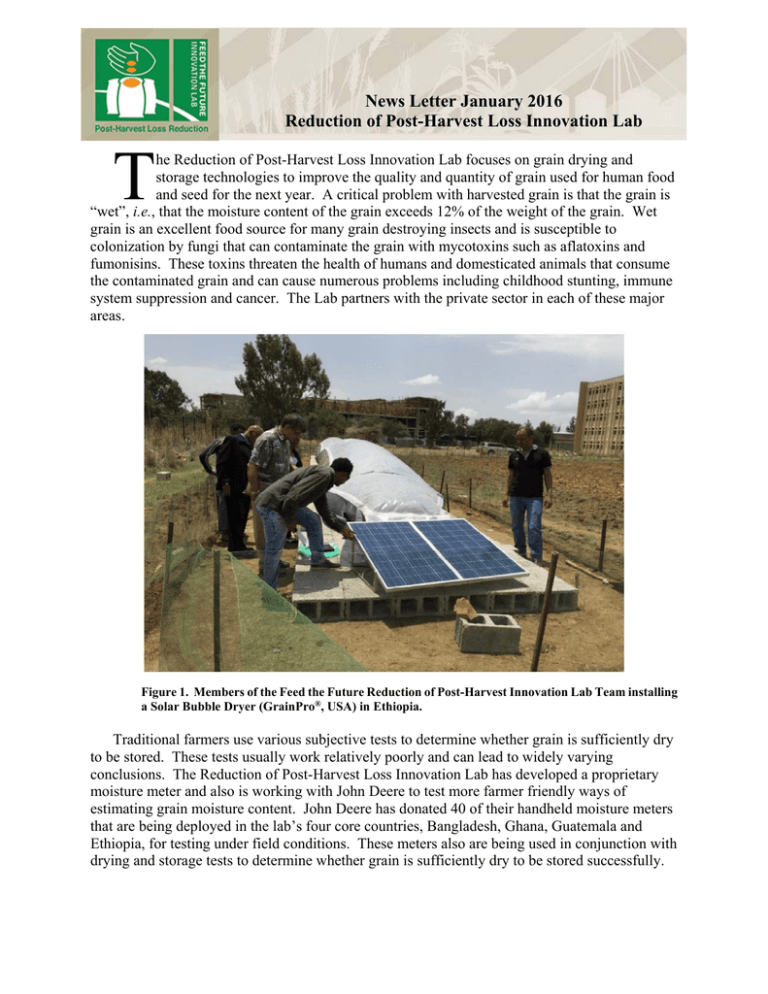T News Letter January 2016 Reduction of Post-Harvest Loss Innovation Lab
advertisement

News Letter January 2016 Reduction of Post-Harvest Loss Innovation Lab T he Reduction of Post-Harvest Loss Innovation Lab focuses on grain drying and storage technologies to improve the quality and quantity of grain used for human food and seed for the next year. A critical problem with harvested grain is that the grain is “wet”, i.e., that the moisture content of the grain exceeds 12% of the weight of the grain. Wet grain is an excellent food source for many grain destroying insects and is susceptible to colonization by fungi that can contaminate the grain with mycotoxins such as aflatoxins and fumonisins. These toxins threaten the health of humans and domesticated animals that consume the contaminated grain and can cause numerous problems including childhood stunting, immune system suppression and cancer. The Lab partners with the private sector in each of these major areas. Figure 1. Members of the Feed the Future Reduction of Post-Harvest Innovation Lab Team installing a Solar Bubble Dryer (GrainPro®, USA) in Ethiopia. Traditional farmers use various subjective tests to determine whether grain is sufficiently dry to be stored. These tests usually work relatively poorly and can lead to widely varying conclusions. The Reduction of Post-Harvest Loss Innovation Lab has developed a proprietary moisture meter and also is working with John Deere to test more farmer friendly ways of estimating grain moisture content. John Deere has donated 40 of their handheld moisture meters that are being deployed in the lab’s four core countries, Bangladesh, Ghana, Guatemala and Ethiopia, for testing under field conditions. These meters also are being used in conjunction with drying and storage tests to determine whether grain is sufficiently dry to be stored successfully. For grain storage, GrainPro®, a Massachusetts based company, has partnered with us to provide Solar Bubble Dryers for testing. This commercially available dryer uses solar energy to power a fan that moves air through the grain to be dried. It also uses solar heat to heat the grain and speed the drying process. The dryers come in 25 and 50m lengths that can dry one to several tons of grain at a time. These dryers are being tested in all four core countries under controlled conditions, and the dryness of the grain before and after drying assessed with the John Deere and the Innovation Lab’s moisture meters to determine their suitability for storage. Grains being tested include wheat, maize, rice, chickpea, and sesame, depending upon the country. Once grain has been adequately dried keeping it dry, and fungus and insect free is the final challenge. These needs are being tested with GrainPro storage bags in all four core countries (and are commercially available in some locations), and with ZeroFly® bags from Vestergaard Frandsen SA (Lausanne, Switzerland) in Ghana. The currently available bags hold 25-50 kg of grain, and bags that can encompass larger static grain sources and that can be opened multiple times are needed. Preliminary results show that both types of bags are very effective storage methods and are superior to the currently commonly used polypropylene bags. Economics is an important issue for both types of bags. At current prices these bags are more likely to be used to store seed between seasons than to store grain destined for human or animal consumption. Identifying local manufacturers for these products so that costs can be further reduced is important for their long term sustainable success. The private sector partnerships that the Reduction of Post-Harvest Innovation Lab has are essential to the success of the Lab and to the increase the quantity and quality of grain available to subsistence farmers in our four core partner countries. Our private sector partners provide commercially available products for testing in these countries and work with us to design these technologies to adequately and economically meet the unique demands required for these products, and others that we develop jointly, both useful and economically sustainable.



